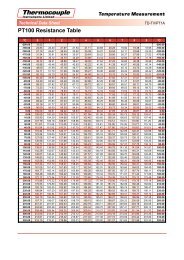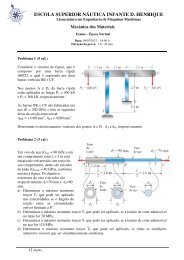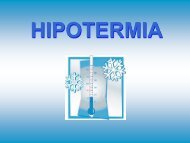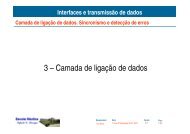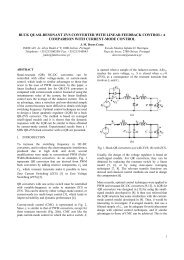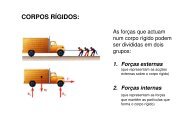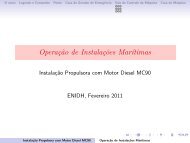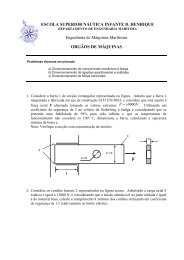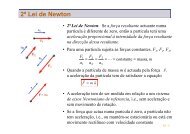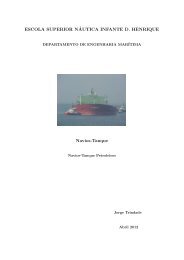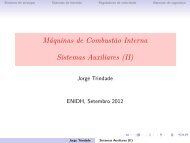Textos de Apoio (pdf)
Textos de Apoio (pdf)
Textos de Apoio (pdf)
Create successful ePaper yourself
Turn your PDF publications into a flip-book with our unique Google optimized e-Paper software.
ITTC – Recommen<strong>de</strong>d<br />
7.5-04<br />
-01-01.1<br />
Procedures and Gui<strong>de</strong>lines Page 7 of 10<br />
Full Scale Measurements<br />
Speed and Power Trials<br />
Preparation and Conduct of<br />
Speed/Power Trials<br />
Effective Date<br />
2005<br />
Revision<br />
03<br />
tion on which mo<strong>de</strong>l tests have been carried out.<br />
This will allow for the correction of the displacement<br />
and trim with respect to the trials<br />
that were conducted and will be applicable to<br />
the suggestions outlined in the ITTC Procedure<br />
for the Analysis of Speed/Power Trial Data.<br />
Draft, trim and displacement should be obtained<br />
at the beginning and at the end of the<br />
trial. This may be accomplished using a loading<br />
computer or by taking a second draft reading.<br />
The accuracy of the draft readings and the<br />
method used to establish draft and displacement<br />
un<strong>de</strong>rway will be compared in port by direct<br />
draft readings both port and starboard in<br />
conjunction with a liquid load calculation.<br />
Displacement should be <strong>de</strong>rived from the<br />
hydrostatic curves by utilizing the draft data<br />
and the <strong>de</strong>nsity of the water.<br />
Environmental factors may significantly influence<br />
the data obtained during sea trials; consequently,<br />
these factors should be monitored<br />
and documented to the greatest extent possible:<br />
• High wind and sea states can force the<br />
use of excessive rud<strong>de</strong>r to maintain<br />
heading, and thus cause excessive fluctuations<br />
in shaft torque, shaft speed and<br />
ship speed.<br />
• Sea states of 3 or less and a true wind<br />
speed below Beaufort 6 (20 Kn) are the<br />
<strong>de</strong>sired conditions for sea trials. When<br />
working un<strong>de</strong>r the time constraints of a<br />
contract, corrections to the trials data<br />
can be ma<strong>de</strong> in accordance with the recommendations<br />
provi<strong>de</strong>d in the ITTC<br />
Procedure for the Analysis of<br />
Speed/Power Trial Data for sea states<br />
less than or equal to 5. For sea states<br />
greater than 5, corrections to the trials<br />
data can be applied but are not consi<strong>de</strong>red<br />
reliable from a scientific standpoint.<br />
• The local seawater temperature and specific<br />
gravity at the trial site are recor<strong>de</strong>d<br />
to enable the calculation of ship's displacement.<br />
• An acceptable minimum water <strong>de</strong>pth<br />
for the trials where the data do not need<br />
to be corrected for shallow water can be<br />
calculated using:<br />
h > 6.0(A m ) 0.5 and h > 0.5 V 2 (1)<br />
with<br />
A m = midship section area, [m 2 ]<br />
V= ship speed, [m/s]<br />
The larger of the 2 values obtained<br />
from the two equations should be used.<br />
• Current speed and direction should be<br />
<strong>de</strong>termined in the test area by prognostic<br />
analysis. When current speed and direction<br />
is unknown, the ship’s global<br />
drift (also including wind effect) in<br />
some cases might be <strong>de</strong>termined by a<br />
360° turning test conducted at low<br />
ahead speed to magnify any environmental<br />
effect.<br />
• The runs should be conducted into and<br />
against the waves; i.e., head and following<br />
seas, respectively. To ensure that<br />
tests are performed in comparable conditions,<br />
the data between reciprocal<br />
runs should be reviewed for consistency<br />
and/or anomalies. Individual speed runs<br />
conducted in the same conditions<br />
should be averaged with their reciprocal<br />
runs to take into account global drift.


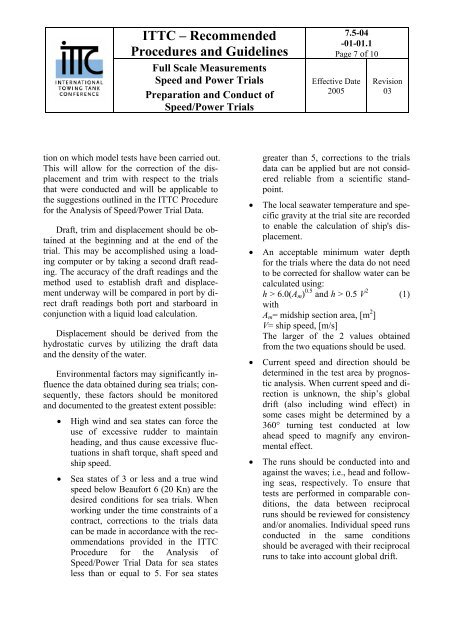
![Conceitos transmissao de dados .Sinais[.pdf]](https://img.yumpu.com/50982145/1/190x146/conceitos-transmissao-de-dados-sinaispdf.jpg?quality=85)
![Packages e interfaces[.pdf]](https://img.yumpu.com/50629553/1/190x134/packages-e-interfacespdf.jpg?quality=85)
